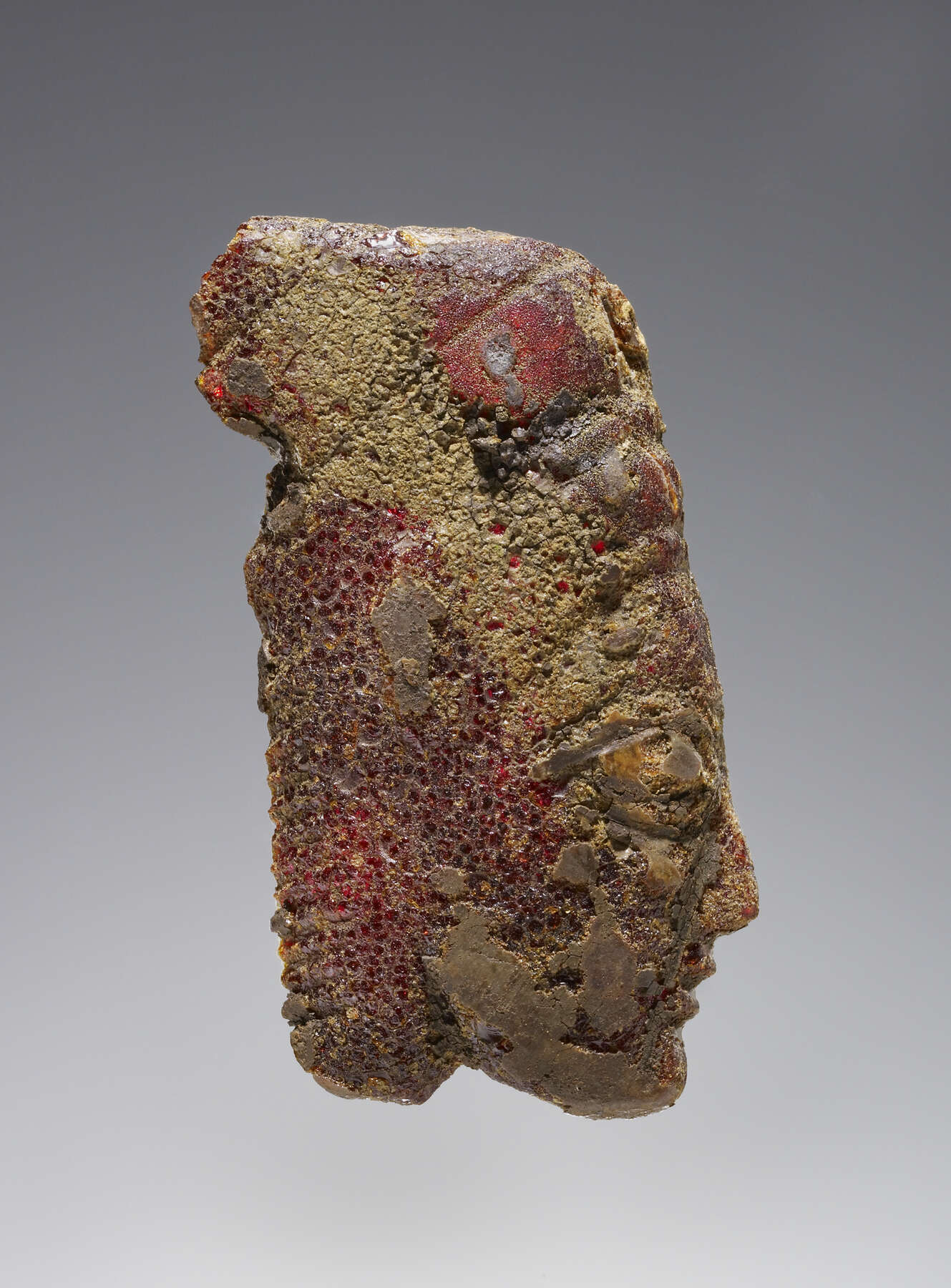17. Pendant: Female Head in Profile
| Accession Number | 82.AO.161.3 |
| Culture | Italic |
| Date | 500–450 B.C. |
| Dimensions | Height: 46 mm; width: 45 mm; depth: 11 mm; Weight: 3 g |
Provenance
–1982, Jiří Frel, 1923–2006, and Faya Frel (Los Angeles, CA), donated to the J. Paul Getty Museum, 1982.
Condition
The pendant is intact, but there are losses on the head and at the suspension perforation exit on the back of the head. The front perforation exit is smoothly worn on its upper edge, suggesting pulling. Details are smoothed at the tip of the cap on the obverse and at the middle of the pendant’s back more than elsewhere, probably through use. The opaque brown surface reflects the original surface level, visible on the cheek and jaw. The surface is crazed, and extensive flaking and cracking all over reveal a reddish, sugary, translucent sublayer. In ambient light, the amber is yellow-brown. At the modern breaks, the interior is translucent and bright orange. In transmitted light, the pendant is translucent and dark red. There are no visible inclusions.
Description
This pendant is oblong, its obverse slightly convex, and its reverse flat and plain. 82.AO.161.3 represents the head and neck of a female in profile. The forehead is broad and rounded. The large, almond-shaped eye is plastic, bulging out almost as in nature; it is recessed at the corners. The lids are rendered as shallow grooves with slightly curved upper and lower rims of varying thickness. Above the eye is the eyebrow ridge, which continues into the temple area. A longer and deeper groove extends from the inner canthus of the eye to the chin, a combination of the nasolabial line and the mouth furrow. The nose is indented at the root. The ears are smooth, rounded shapes at the angle of the jaw; the right ear is more legible than the left. The area between the nose and the upper lip is short. The upper lip slightly overhangs the lower. The mentolabial sulcus is a shallow curve. Although the chin is prominent, it is recessed from the line of the brow. The jaw intersects the neck, forming a small, recessed triangular area.
The figure wears a conical cap covered with a wrapping of cloth (showing three distinct sections), and over it a crown. No hair shows on the forehead. At the back of the head is a fall of hair (a ponytail-like section?) marked with diagonal grooves, except for the plain terminal section.
The carver has taken advantage of natural protrusions in the original amber blank for the modeling of the face. The long groove that runs from the temple to the top of the cap is plausibly a trace of fissure removal. The suspension perforation runs laterally through the top of the headdress, causing the pendant to hang slightly to its left, with the forehead tilted forward, the chin backward.
Discussion
This head-pendant is similar to a large and varied group of female head-pendants that includes works documented as coming from various sites in peninsular Italy and Corsica.1 82.AO.161.3 is especially close to two head-pendants from a sporadic find, a tomb group at Roscigno–Monte Pruno (Salerno, Museo Provinciale), and with two head-pendants from the Spina–Valle Lege Tomb 740B.2 They may all be of comparable date and reflect a common sculptural prototype. The Roscigno tomb is dated to the end of the fifth or beginning of the fourth century, and the terminus ante quem for the burial of the Spina head-pendants is no later than the mid-fifth century B.C.
Notes
Bibliography
- Due donne 1993
- Baldoni, D., ed. Due donne dell’Italia antica: Corredi da Spina e Forentum. Exh. cat. Padua, 1993.
- D’Ercole 2008
- D’Ercole, M.-C. Ambres gravés du département des Monnaies, Médailles et Antiques. Paris, 2008.
- La Genière 1961
- La Genière, J. de. “Ambre intagliate del Museo di Salerno.” Apollo 1 (1961): 73–88.
- Losi et al. 1993
- Losi, M., B. Raposso, and G. Ruggiero. “The Production of Amber Female Heads in Pre-Roman Italy.” In Amber in Archaeology: Proceedings of the Second International Conference on Amber in Archaeology, Liblice, 1990, edited by C. W. Beck and J. Bouzek, pp. 203–11. Prague, 1993.
